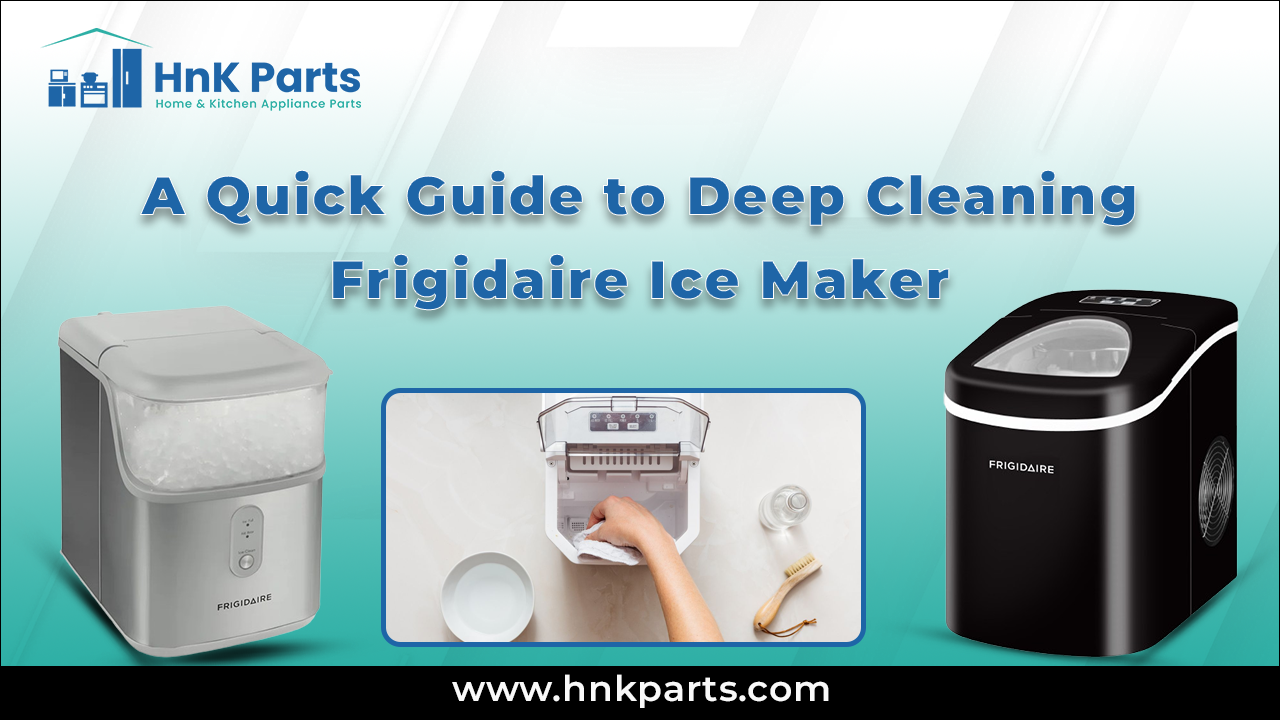How to Clean Frigidaire Ice Maker: Easy Steps
This post contains affiliate links. As an Amazon Associate, we earn from qualifying purchases.
That first sip of water with cloudy, oddly tasting ice cubes isn’t refreshing—it’s frustrating. When your Frigidaire ice maker produces off-flavored ice or slows to a crawl, mineral deposits and hidden mold are likely choking its internal systems. Left unaddressed, these issues trigger costly repairs or premature failure. This guide delivers the exact steps to deep-clean your Frigidaire ice maker safely in under 60 minutes using household supplies. You’ll restore crystal-clear ice production while extending your appliance’s lifespan by years.
Most homeowners overlook how quickly hard water minerals coat freezing surfaces and how mold thrives in damp corners. Regular cleaning isn’t optional—it’s what separates ice makers that last 10+ years from those needing replacement in half that time. Follow this battle-tested process to eliminate buildup, sanitize critical components, and guarantee fresh-tasting ice starting with your very next batch.
Unplug and Power Down Your Frigidaire Ice Maker Correctly

Never skip this critical safety step—Frigidaire ice makers contain heating elements that stay dangerously hot after shutdown. Begin by locating the power cord behind your unit and pulling it straight from the outlet. If your model connects to a dedicated water line, find the shut-off valve (usually under the sink or near the fridge) and turn it clockwise until snug. Place thick towels around the base immediately; melted ice creates surprising puddles during cleaning.
Why Immediate Power Disconnection Matters
Electric shock risks escalate when water contacts live components, especially during interior cleaning. Unplugging also prevents accidental activation that could damage internal mechanisms. For models with a dedicated disconnect switch, flip it to “off” position first—this provides an extra safety layer before handling the plug. Always allow heating elements 20 minutes to cool completely before proceeding; touching hot surfaces causes severe burns.
Gather These Exact Cleaning Supplies Before Starting

Assemble every item before disconnecting power—mid-clean supply runs risk leaving harsh chemicals on sensitive parts. Your Frigidaire requires specific non-abrasive materials:
- 1 gallon cool water (hot water warps plastic components)
- Mild unscented dish detergent (lemon varieties leave residues)
- Two soft microfiber cloths (never use paper towels—they shed)
- Unscented household bleach (1 tbsp per gallon ratio only)
- White vinegar (exclusively for filter cleaning)
- Cotton swabs (for crevice sanitizing)
Critical Supply Mistakes to Avoid
Steel wool, ammonia-based cleaners, or dishwasher detergent permanently damage internal coatings and leave toxic residues in your ice. Never substitute vinegar for bleach during sanitizing—mixing them creates dangerous chlorine gas. Store-bought “appliance cleaners” often contain abrasives that scratch freezing surfaces, accelerating future buildup.
Spot Problem Areas With a 2-Minute Visual Inspection
Before disassembling anything, conduct this targeted inspection. Shine a flashlight into corners where mold hides and examine water entry points for mineral crusts. Look specifically for:
- Chalky white deposits around water nozzles (hard water buildup)
- Black specks in ice bin seams (mold colonies)
- Rust-colored streaks on metal parts (corroded water lines)
- Ice clumping across the storage bin (residual moisture issues)
- Cracks in plastic housing (requires professional repair)
Document problem areas with your phone camera. This creates a before/after reference to verify cleaning effectiveness and identifies recurring issues needing professional attention.
Remove and Clean the Ice Storage Bin Without Damage
Pull the bin straight out—most Frigidaire models lift slightly then slide forward. Never force it; plastic guide rails snap under pressure. Empty all ice immediately—even “clean” cubes absorb freezer odors and contaminants over time. Run warm tap water through the bin to melt stubborn clumps, but avoid hot water that warps plastic.
Proper Bin Washing Technique
Wash the bin using warm, soapy water and a microfiber cloth. Focus on corners where ice sticks—this is mold’s favorite breeding ground. Rinse under cool water until runoff is completely clear, then dry thoroughly with a clean towel. Any residual moisture causes ice bridging (fused cubes) during the next cycle. Critical warning: Never use knives or metal tools to chip ice—scratches in the plastic become bacteria traps.
Clean or Replace Your Frigidaire Water Filter System
Locate your filter in one of three common spots: inside the ice maker (twist-off cylinder), inline on the water supply line behind the unit, or shared with your refrigerator under the sink. For replaceable filters, note the installation date on the new filter with permanent marker—most require changing every 6 months (3-4 months with heavy use).
Reusable Filter Deep Cleaning Protocol
Create a 50/50 white vinegar and warm water solution in a bowl. Submerge reusable filters for 30 minutes, gently swirling every 10 minutes to dislodge mineral deposits. Rinse under cool running water until vinegar odor disappears completely—residual vinegar ruins ice taste. After reinstalling, run two full ice cycles and discard the ice to flush loosened debris from the system.
Sanitize Critical Surfaces With Safe Bleach Solution

Mix your sanitizing solution fresh: 1 tablespoon unscented bleach per 1 gallon cool water. Bleach degrades after 24 hours in diluted form, making pre-mixed solutions ineffective. Dip a microfiber cloth in the solution, wring until barely damp, and wipe all exterior surfaces—especially control panels and door seals where bacteria accumulate.
Interior Sanitizing Without Damage
Use cotton swabs dipped in solution for tight crevices around freezing fingers. Avoid direct contact with metal freezing surfaces—they’re razor-sharp and easily nicked. Let the solution sit for exactly 10 minutes to kill mold and bacteria, then wipe all surfaces with clean water until bleach odor vanishes. Residual bleach creates chemical-tasting ice and corrodes components over time.
Reassemble and Run First Test Cycle Properly
Reinstall components in reverse order of removal. The ice bin should slide in smoothly—if resistance occurs, realign guide rails before forcing. Most Frigidaire models require holding the power button for 3 seconds after reconnection. Listen for the initial water fill within 2 minutes; absence indicates misalignment.
Post-Cleaning Test Protocol
Discard the first three full ice batches—these contain residual cleaning solution and dislodged minerals. Fresh ice should appear crystal-clear with neutral taste. Monitor production for 24 hours; healthy units generate 8-10 batches daily. Slower output signals remaining blockages requiring professional service. Pro tip: Place a glass under the dispenser during the first cycle to verify water flow clarity.
Prevent Future Buildup With This Maintenance Schedule
Set recurring calendar alerts using this proven timeline:
– Monthly: Empty bin completely if unused for 48+ hours
– Every 3 months: Quick bin wash and exterior wipe (15 minutes)
– Every 6 months: Full deep clean including filter (45 minutes)
Hard Water Adjustments and Warning Signs
In hard water areas (over 120 ppm), shorten deep cleans to every 4 months. Install a water softener to extend intervals. Clean immediately if you notice:
– Metallic or musty ice taste
– Persistent cloudiness despite clear water
– Production dropping below 5 batches daily
– Water pooling at the unit’s base
Mark your next cleaning date now—consistent maintenance prevents 3-hour emergency deep cleans later.
Fix 5 Common Issues After Cleaning Your Ice Maker
Ice maker won’t restart after cleaning
Check bin positioning—most Frigidaire units have sensors requiring perfect alignment. Remove and reinstall the bin, listening for a distinct “click” when seated correctly.
Slow ice production post-cleaning
Inspect the water supply line behind the unit for kinks caused during reassembly. Gently straighten any sharp bends without twisting the line.
Loud noises during operation
Air trapped in water lines causes gurgling or knocking sounds. Run three complete ice cycles—the noise should cease as air purges from the system.
Ice cubes clumping together
Residual moisture in the bin causes fusion. Ensure thorough drying with a microfiber cloth before reinstallation—no visible dampness should remain.
Musty odor in new ice
Double-rinse all components after sanitizing. Vinegar or bleach residue creates persistent odors—repeat rinsing until no chemical scent remains.
Clean ice isn’t a luxury—it’s your Frigidaire’s factory promise. By following this exact process every six months (or quarterly in hard water areas), you’ll consistently produce crystal-clear ice while adding years to your appliance’s life. The 45-minute investment prevents $200+ repair bills and guarantees every glass tastes as fresh as it should. Start your next cleaning session today using the supplies checklist, and never tolerate cloudy, off-tasting ice again. Your freezer deserves to deliver what it was engineered for: perfect ice, on demand.
